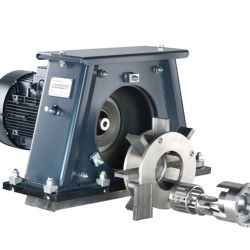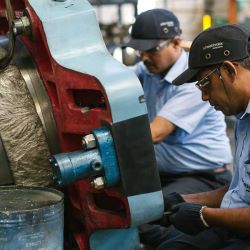A quick A-to-Z of shot blasting and surface preparation machine terms
Usually, the names of the machines describe how the component passes through the machine.
But sometimes the name describes the component to be treated, the chamber in which the component is treated, or the form of treatment. Added to that you need to determine how you want the components to flow through your production process.
The Flow
| Term | Explanation |
|
Batch |
A batch or group of components enter the blast chamber together, are processed together, and exit the chamber together through the same chamber opening. Example: MB Batch Type Tumblast Machine |
|
Continuous |
The movement of components through the blast chamber and to the next process is continuous, normally without stopping. Example: CT Continuous Tumblast Machine |
|
Inline or In-line |
The movement of components through the blast chamber and to the next process is achieved in one continuous line. However, the line may pause to allow the components in the blast chamber to be blasted in one concentrated area. Example: DHB-C Pass-Through Monorail Machine |
|
Indexing |
The components move into the blast chamber, are stationary, then move to the next process. |
|
Closed Loop |
The components are fed through the blast chamber on a circular (closed loop) transportation device. They therefore have to be loaded and unloaded from the transportation device. Example: DHB-C Pass-Through Monorail Machine |
|
Through-feed or Pass Through |
Components enter the blast chamber via one opening, and exit from another. The components are transported at a constant (yet variable) speed. Example: Roller conveyor machines |
|
Rotary through-feed |
As in through-feed, but the components are rotated while passing through the machine. Example: RDS Spring Peening systems |
|
Closed Circuit |
Closed Circuit describes the movement of the abrasive. Closed circuit machines are compact portable air blast machines and move to the component to be blasted. Example: Closed circuit blast machine |
|
Component Movement Names
| Term |
Explanation |
Hanger type, or Overhead rail |
Components are suspended on a hanger or tree hanging from a rail. The tree is then transported into the blast chamber, where it is blasted often while rotating. Once blasted, the hanger is transported back out of the chamber – usually from the same entrance. It is common to have a track or rail in a Y formation, allowing two hangers, so that a new batch of parts can be loaded, while one batch is being processed. Example: HT Overhead Monorail Machine |
Monorail, or Pass-through monorail |
As above, but this time the rail is continuous, or circular (closed loop), and passes completely through the blast chamber. Example: DHB D Pass Through Monorail Machine |
Frame machine |
Components are fixed or hung in a frame, the frame moves into the blast chamber and airblast robots blast the components. The frames can be stationary while in the blast chamber, indexing or continuously moving. The Frames pass through the chamber. |
Spinner hanger |
The hanger is fixed inside the blast chamber. The blast chamber usually has two compartments, so that parts can be unloaded and loaded in one compartment while the hanger in the other compartment is being blasted. The hanger spins to achieve complete coverage. Example: SPH Spinner-Hanger Type Machine |
Roller conveyor |
Components – usually long and low parts such as plate steel and H bars – are rolled on bars, on a conveyor line through the blast chamber. The components are transported at a constant (yet variable) speed. Blast wheels are positioned above, and sometimes below the conveyor, to blast the parts. Example: Roller Conveyor Type HD |
Work car, or Bogie table |
The Work car – essentially a table on wheels moving along a track – is used to transport heavy components and fabrications, such as bridge girders and large weldments or castings, into the blast chamber. Work cars can pass through the chamber, or enter and exit from the same door. They can also rotate if required Example: Work Car BGM Machine |
Tumblast |
Components are tipped into a tumbling barrel-type drum. They gently roll over each other, are blasted, and are tipped out again via the same opening. The drum can be made of a wear-resistant rubber or steel conveyor. Example: MB Batch Type Tumblast Machine |
Polygon-drum systems |
Polygon drum systems are polygon-shaped troughs which rock back and forth to gently tumble the parts while blasting. Example: DTC Batch Type Tumblast Machine |
Horizontal belt |
Components are conveyed (linear transportation) at a constant speed (variable) along a belt through the blast chamber. Belts can be made of hard wearing rubber, or steel mesh/manganese mesh. |
Chamber Descriptions
| Term |
Explanation |
Manual or Hand cabinet |
Airblast application – a component is loaded in a cabinet, via a side door, where it is blasted by hand. Gloves are in-built into the machine, the operator inserts his hands into the gloves, picks up a hose/nozzle, and manually blasts the part |
Blastroom |
Parts are transported into a room, where an operator in a full suit and helmet, will manually blast the components – although automated versions are also available. Example: Blastroom |
Component Descriptions
|
Term |
Explanation |
Concrete block machine |
A horizontal wheel blast machine to give a high quality finish to concrete blocks and paving slabs. Linear transportation, at variable constant speed. Example: Concrete Block machine |
Pipe machine |
Pipes are transported through the machine on a skew roll conveyor to turn the pipe while the blast stream removes mill scale and rust. Example: Pipe machine |
Stress peening system |
For shot peening springs. A predefined load is applied to each spring during peening on a satellite table machine. Example: SRS Stress peening machine |
Strip descaling |
Narrow, medium and wide steel strip is fed through a machine horizontally as part of an integrated processing line. Example: Strip descaling machine |
Wire bar and billet descaling |
Single or multiple strands of wires and bars are fed through the machine, which can be standalone, or integrated into a drawing line. Example: Wire, Bar and Billet Descaling |
Preservation line |
A preservation line is a roller conveyor machine which transports sheet steel through many processes including preheating, shot blast cleaning, priming and drying. Example: Preservation Line |
Internal cleaning |
The airblast advanced internal cleaning machine is a pass through, horizontal machine. A roller conveyor transports the component – cylinder heads, motor blocks, crank cases etc. – into the blast chamber, where a pivoting device lifts the component towards the nozzles. Pivoting nozzles may also simultaneously blast the underside apertures and bores. |
Gear peening cells |
Airblast, satellite table machines with specific tooling to hold and rotate parts, With complex parts recognition technology for precise, process reliable, repeatable shot peening results. Example CFX 600 |


